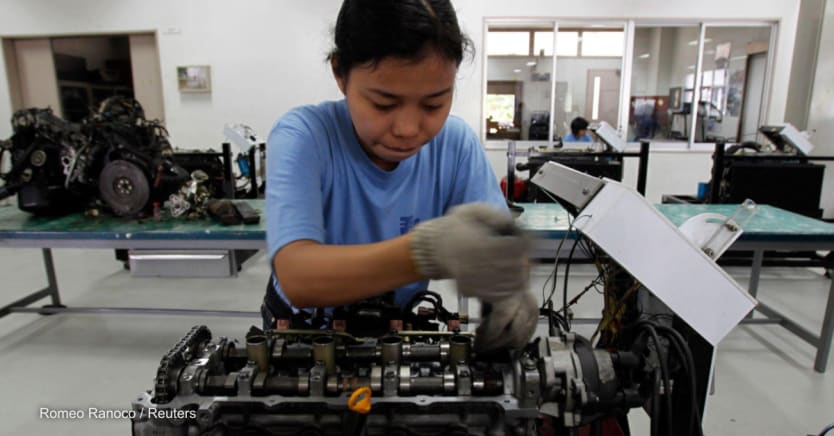
The U.S. Agency for International Development’s newest update to its Youth in Development Policy features “systems” as an important principle in achieving youth development outcomes in low- and middle-income countries.
While the official policy update has not yet been released, Objective 3 of the draft update states that “Youth have a stronger collective voice in, and are better served by, local and national systems through more coordinated and effective services, practices, and policies that embody the principles of positive youth development.” A similar theme “start with the local system” is Principle 1 in USAID’s Local Capacity Development Policy.
We’ve seen increasing attention to systems thinking in global development, including exciting work in the field of market systems development and in the education sector. We’ve also seen more systems-informed implementation practices, such as systems analysis, complexity-aware monitoring, and collaboration, learning, and adaptation, or CLA.
Our understanding of youth systems in LMICs is relatively nascent, but that’s starting to change. Over the past three years, I’ve been working with the Education Development Center to understand how systems thinking can help countries achieve more sustained, equitable, and scaled youth employment outcomes.
Notably, EDC has been a leading member of the Youth Systems Collaborative, a group of international organizations promoting learning about youth systems. Together we developed the Youth Systems Framework: A tool that helps youth system actors understand how their youth system is working to support young people. Using that framework as a guiding structure, EDC is generating evidence about the youth workforce development systems of different countries such as Rwanda, Senegal, and the Philippines.
So what are our key takeaways from our research in youth systems? Comparing EDC’s research with that of the Youth Systems Collaborative, below are some common findings we have discovered:
1. Intentional scaling strategies
Global youth development programs play an important role in introducing innovations in service delivery. To scale and sustain these investments, there needs to be an intentional strategy to facilitate change among a diverse set of local actors.
Consistent and widespread data collection, user-friendly communications, and the targeted outreach and engagement of strategic partners have shown to make a difference in influencing other system actors toward positive change. In one partnership model, EDC worked closely with the ministries of education in Senegal and Rwanda to conduct a cost-economy analysis of new work readiness curriculum and services. This analysis process set the foundation for the ministries to institutionalize and scale these services nationwide.
2. Being an ‘attractor’ for behavior change
Visible evidence of what can be is a powerful catalyst for shifting people’s norms and mindsets. EDC has seen how effective workforce development programs can lead to shifts in youth’s perception of the value of a technical and vocational certificate. We have also seen employers change their recruitment and hiring practices so that they are more inclusive of women, out-of-school youth, and youth with disabilities. And we have seen changes in the collective understanding of the role of education: In Senegal, one partner during a reflection workshop noted that for the first time “the word entrepreneurship has entered the vernacular” because of the secondary education reforms that were happening with EDC’s programmatic support.
Sustained youth development outcomes come from these kinds of widespread behavior changes. EDC is now working to incorporate such behavior change into our development hypotheses, and capture these changes over time as part of our approach to CLA.
3. Youth engagement
Engaging youth as system actors is more than a nice thing to do: It is an important piece to scaling youth outcomes. At EDC we are starting to find, for example, that peer networks offer a low-cost, last-mile service delivery solution for youth to access entrepreneurship and business development services. More research is needed on the efficacy and scalability of these youth engagement approaches. We especially need more examples of how other actors have made space for youth engagement across the system.
4. National and subnational visioning
Meaningful changes require both national and subnational system actors to be mobilized around a common vision. As a global development organization, EDC is rethinking its role in supporting a multistakeholder vision for change. In the field of youth skills development, we have found the most positive and widespread changes happen in countries that are committed to a clear national workforce development agenda that is tied to their economic and trade policies.
At the same time, we are finding that donor-funded programs offer value when they support the formation of subnational public-private alliances, which mobilize the resources and will of local stakeholders around collectively held youth development goals.
Implementing USAID’s youth policy
As USAID and its implementing partners move from systems thinking to systems practice, the new youth policy will require us all to refine our approaches, including:
• Developing participatory tools and approaches for appraising youth systems, and for setting a collective vision and set of actions for change.
• Continuing to research and learn from youth systems work in LMICs.
• Creating ways to measure systems change — and in a way that is meaningful for local system actors, international programs, and for donors who seek tangible, short-term results.
I invite others to join EDC and the Youth Systems Collaborative in this collective effort.
Update, May 9, 2022: This article has been updated with USAID’s latest Youth in Development Policy.








